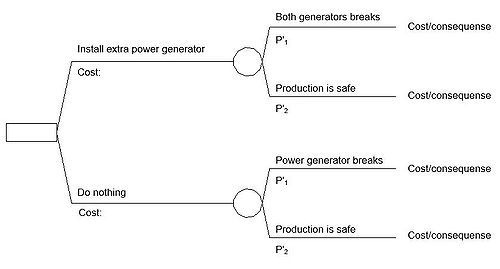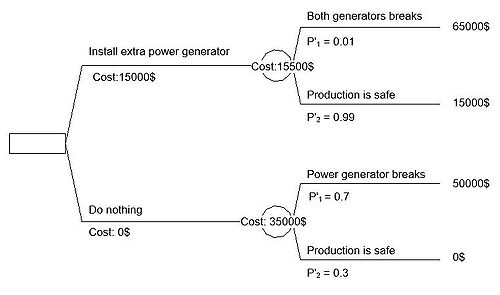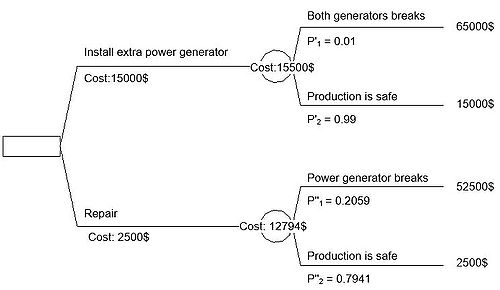Decision Tree: Risk & Opportunities
Developed by Klavs Skovby
Uncertainty is a massive issue in project management and can lead to high cost and negative impacts if not handled correctly. The project manager must therefore be able to make the best decisions based on the information available.
First the project manager must be able to localize risks and gather information on the problem.
Then the project manager becomes the decision makers as he will have to analyse and make choices on the obtained information.
The decision tree is a tool that can aid the project manager to ensure the best outcome of a problem.
It is based on a tree-like model where each branch is a path of decisions and possible events. Each step include the cost and possibility of that event to occur.
By identifying all the possible events and their chance to occur it gives the project manager the ability to calculate the highest probability for each path.
When combining this with the cost of each event the project manager is able to estimate the cost/benefits for each decision.
This article will also have a look on the decision trees limitations and other alternatives for decision making.
Contents |
Introduction
Decisions and uncertainties is something we experience almost every day. It might not be huge deal for the normal person. However for a project manager decisions and uncertainties can be huge and costly problems if not handled correctly. It is therefore important for the project manager to be able to localize and do problem solving in the best possible way. To make a qualified decision there are four steps the manager should go through[1]
1: Identification of the problem and gather proper information
2: Identify limitations
3: Find alternatives and analyse them to select the best solution
4: Apply the solution to the problem and monitor the outcome
There are many different tools to aid the project manager with this. The decision tree is one of those tools which can aid the decision-maker in his process. The decision tree is a way to structure decision and the probability of events that occur from the decision. With information as consequence of each event the project manager is able to select the best expected outcome. The decision tree is a powerful tool and can fit many tasks. It is however not suited for every task and the project manager should therefore be able to know its limitations as well.
Identification
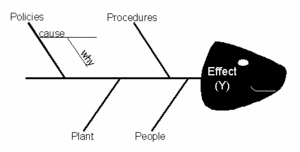
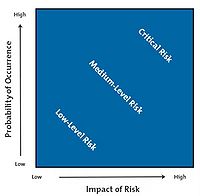
[4]It is important for the project manager to identify the risks before a decision is made. Best decisions are based on information therefore it is crucial for a good project manager to start early in a project to gather information. Having the information early on will mitigate the possibility of an unforeseen event occurring. However even the best project manager will not be able to predict all risks within the projects timeline.
All information must be processed and put in the right categories to be successfully used. This include positive and negative outcomes (opportunities and threats for the project)
There are different kind of tools to help the project manager and his/hers team to identify and manage the risks. One is to stimulate and capture the ideas from the teams brainstorming on the root of the causes with the cause and effect diagram a.k.a Fishbone[2].
With this the team is able to localize the problem (effect) and what causes it. When the cause and effects are found the team is able discuss why the problem happen. All this information can then be gathered for further analysation and problem solving.
When the risks are identified and classified the project manager has many tool available to assess them. Probably one of the most popular ones is the probability/impact matrix. The matrix is a square where the project manager organize all found risk. The x-axis goes from low to high with the impact of risk. The y-axis is from low to high with the probability of occurrence. This is seen on figure 2. The risk in the top right corner is of critical importance and should be primary focus for the project manager. However in the lower left corner are of low importance and can mostly be ignored. The probability/impact matrix is a great way to organize and show which risk that should be focused on when taking decisions.
Method Description
[5]
A decision dilemma is where a person has to chose between a minimum of two options for the best outcome. An everyday situation could be if you are going to remodel the bathroom in your apartment and you are choosing between two contractors. Contractor A is the cheapest but is also known for having the probability of delays. Whereas contractor B costs more but have a greater chance of finishing in time. In both of them decisions and uncertainties are present in the terms of cost and delays. So which one do you choose? Obviously you would choose the outcome with the highest value or the one with the lowest negative impacts.
To better understand the problem let us say that contractor A will cost $35000 and with a 25 percent probability to not finish in time. Whereas contractor B will cost $50000 with a 90 percent probability of finishing in time. If either one of them fail to finish in time there would be a penalty on $10000.
Even with this small situation it can be hard to choose the best solution if no analysis of the problem is done. In larger projects there can be many decisions and uncertainties and many of them can be as a consequence of an other decision. It is therefore crucial for the decision maker to have the right tools and be able to handle them. This is where the decision tree comes in handy.
The decision tree is a method to evaluate a decision making process. It is a tool that is commonly used within robotics, machine learning, statistics data mining and management. This article focus on the use within project management.
For a project manager the Bayesion decision tree analysis[6] is used to mitigate the risk and cost of the decision.
It is useful when analyzing a process that is a combination of many decisions as the user is able to calculate the effect of each decision.
The decision tree is a model with three types of stages:
● A decision node (square)
● An event node (circle)
● A cost/consequence node
At the decision node the project manager has to take an active choice to move on. The event node is the effect that can happen from a choice taken. The last type of node is the cost/consequence which is the end result of decisions and events occurring.
Figure 3 shows the basic decision problem situation. It is a medicinal company that is investigating if they should install an extra power generator. If the power generator breaks down they would have to shut down production until it is fixed. A shut down could lead to massive expenses and on the same time investing in an extra power generator is also expensive.
First the decision node is whether they should install the power generator or not. Both of the decisions leads to an event where there is a chance of two possible outcomes.
The theory behind the decision tree is to calculate the average outcome of each decision taken. In short called the Expected cost and can be expressed as this simple equation:
Expected cost = Probability of risk * Impact of the risk
E=P*I
Application of the method
In the following the medicinal company's decision problem will be revisited and used as an example with the use of the Bayasian decision analysis[6]
Decision analysis - Prior
To complete the decision tree. Cost information of each stage and the probability of each event occurring must be estimated. This is typically done in the identification and assessment phase.
For the ease there have been made some cost and probabilities for this case. The extra power generator cost $15000 to install and the aftereffect of the generator breaking down will cost $50000
If no action is taken there is a 30% chance that the production is safe and 70% it is not.
By installing the generator the production has a 99% to be safe. With extreme bad luck there is 1% chance that both the generators break down.
In the end of each branch the expenses of each decision and events are summarized. The expense will therefore add up to $65000 for the path where both generators break down as the production will get stalled as well.
Based on the prior information the expected cost can now be calculated for each branch as seen with E1 and E2


The best decision would then be to take the minimum of the two expected costs. In this situation it is the path with the extra generator. In that decision there is still the chance of having to pay the full amount of an extra generator plus production shut down. But in the perspective of the probability of the other choices outcome this one delivers the best opportunity.
Decision analysis - Posterior
If additional information becomes available the decision tree model can be updated and re-evaluated with the posterior analysis.
Given the same case the company would try to perform a repair on the current power generator to improve the probability of success.
The project manager wants to hire an external company that could do an investigation/repair on the generator for the price of $2500. The external repair company promises that they can deliver a repair which have a 90% chance of fixing the problem.
The decision table is now getting additional information and the updated probability can be calculated with this equation (Bayers' rule).
![P''[\theta_1|I_1] = \frac {P[I_1|\theta_1] \cdot P'[\theta_1]}{P[I_1|\theta_1] \cdot P'[\theta_1] + P[I_1|\theta_2] \cdot P'[\theta_2]}](/images/math/6/f/a/6fa04239804afc1e61b3e179fe5629a5.png) [6]
[6]
In the table below are the chance of a repair to be successful.
| θ2 Success | θ1 Failure | |
|---|---|---|
| I1 Repair | 0.9 | 0.1 |
| I2 No repair | 0.1 | 0.9 |


The updated probabilities are calculated and a new evaluation can be made. The estimated cost for the repaired power generator situation is then:

With the additional information the best decision has changed to the other where there is no need for investment of an extra power generator.
Decision analysis - Pre-posterior
The decision maker normally have the possibility to buy extra information before making his decisions (In this case it was the repair company) The information is worth buying if the cost is low compared to the value of the information. If different options to improve the decision are available the project manager must chose the option which yield the overall largest expected value. With pre-posterior analysis the decision maker is able to facilitate if the information is worth buying or not.
Limitations
[7] The decision tree offers many advantages when comparing to other decision making tools as it is easy to understand and simple to use. However the decision tree also has its disadvantages and limitations.
The information in the decision tree relies on precise input to provide the user with a reliable outcome. A little change in the data can result in a massive change in the outcome. Getting reliable data can be hard for the project manager for example how would you set the probability of a repair being a success or failure. The estimated cost could be way off if several events in a row has been estimated 10% wrong.
Another fundamental flaw is that the decision tree is based on expectations that will happen for each decision taken. The project managers skills to do predictions will however always be limited. There can always be unforeseen events happening from a decision taken which could change the outcome of the situation.
At the same time the decision tree is easy to use it can also be very complex and time consuming. This is seen when using it on large problems.
There will be many branches and decisions which takes long time to create. With extra information added or removed the manager would probably have to re-draw the decision tree.
Having large project can easily make the tool unwieldy as it can be hard to present for colleagues if they have not been on the project from the start.
Even though the decision tree seem to be easy it requires skill and expertise to master. Without this it could easily go wrong and could be at high expense for the company if the outcome was not as expected. To ensure the expertise the company would have to maintain their project managers skills which could be expensive.
Having to make a decision based on valuable information is good. However having to much information can go in both ways. The project manager can hit the "paralysis of analysis"[7] where he got a massive challenge to process all the information which will slow down the decision making capacity. Having to much information could therefore be a burden in both cost and time on analysis.
Alternatives
[1]
As project management is a discipline which is heavily dependent on the decision-making. There have been created many tools to help the project manager in the decision-making phase.
Alternatives to the decision tree is the SWOT analysis which stands for Strength, Weakness, Opportunity and Threat. It bring unsorted issues to a conclusion using a 2x2 matrix by focusing on identification of internal (strength and weakness to the project) and external factors (opportunities and threats to the project)
Another alternative is the Monte Carlo Simulation which is a method of probability analysis that runs with a number of variables to determine different outcomes. This is typically a computer run simulation as the variables can have a huge range. When the simulations is done the decision-maker can plot the result on a probability distribution curve. Based on the shape of the simulations the decision-maker can then make the best decision based on the risk they are willing to take.
Furthermore an other alternative could be Pareto Principle which is know as the 80/20 rule. This rule states that about 80% of the effects are from 20% of the causes. Locating the 20% can therefore help the project manager be more efficient in decision making.
They are all different methods to aid the project manager and none are similar. It is a must to have knowledge within all of them to realize which one of them fits the problem if you want to be a good decision maker within project management.
Conclusion
Without proper risk management every project is doomed to failure. It is crucial for the project manager to understand and master the different tools of risk management to predict problems before they occur and handle them correctly. The decision tree is a great tool for the decision-maker but is also has its limitations and would not be suitable for every situations. Even though it is a tool that is easy to use. It require skills to know when and where it can be used without being a time demanding and costly affair.
Annotated Bibliography
- Faber, Michael Havbro. "Statistics and Probability Theory - In Pursuit of Engineering Decision Support" Chapter 7 p. 143-154
- In this chapter Michael explains the usage of the decision tree and shows other examples on how to use the Bayasian prior, posterior and Pre-Posterior theory.
- Winch, Graham M "Managing Construction Projects", 2nd Edition, 2010, Chapter 13 p.346-368
- In this chapter Graham goes into depth of managing uncertainty and risk on a project. The chapter has focus on identifying and how to assess the risks.
- N Nayab "Disadvantages to Using Decision Trees" ,2011
- For a deeper level of understanding of the disadvantages/limitations when using the decision tree. Here the major subjects are Instabillity, Complexity, Unwieldy, Cost, Too much information and Analysis limitations.
References
- ↑ 1.0 1.1 Snehal Joshi , Decision Making Models In Project Management, Link: https://www.projecttimes.com/articles/decision-making-models-in-project-management.html.
- ↑ 2.0 2.1 Kerri Simon , The Cause and Effect (a.k.a. Fishbone) Diagram, Link: https://www.isixsigma.com/tools-templates/cause-effect/cause-and-effect-aka-fishbone-diagram/
- ↑ The Mind Tools Content Team , Risk Impact/Probability Chart, Link: https://www.mindtools.com/pages/article/newPPM_78.htm/
- ↑ Graham M. Winch (2010) Managing Construction Projects - An Information Processing Approach 2nd Edition, Publisher: Blackwell Publishing Ltd.
- ↑ Satya Narayan Dash (2017) PMP Prep: Decision Tree Analysis in Risk Management, Link: https://www.mpug.com/articles/pmp-prep-decision-tree-analysis-in-risk-management/.
- ↑ 6.0 6.1 6.2 Michael Havbro Faber (2010) Statistics and Probability Theory - In Pursuit of Engineering Decision Support, Publisher : Springer International Publishing.
- ↑ 7.0 7.1 N Nayab (2011) Disadvantages to Using Decision Trees, Link: http://www.brighthubpm.com/project-planning/106005-disadvantages-to-using-decision-trees/.
